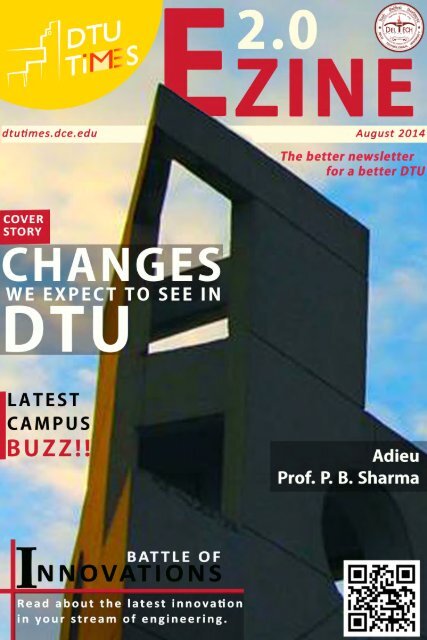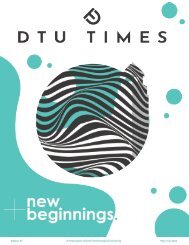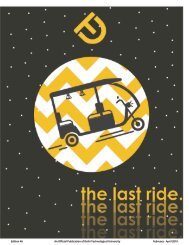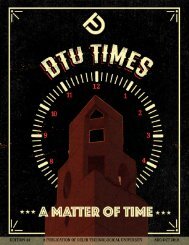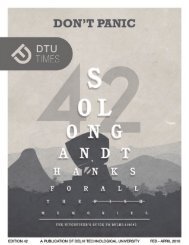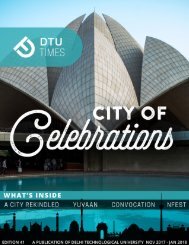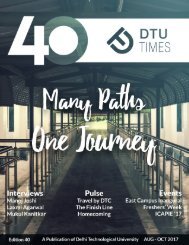E-Zine 2.0
Create successful ePaper yourself
Turn your PDF publications into a flip-book with our unique Google optimized e-Paper software.
2 DTU TIDINGZ<br />
www.dtutimes.dce.edu<br />
Adieu Prof. P. B. Sharma<br />
A<br />
farewell was organised for our former<br />
Vice Chancellor, Prof. P.B. Sharma,<br />
in the Senate Hall of our college on<br />
22nd July, 2014. The event was organised<br />
to honour Prof. P.B. Sharma’s immense<br />
contribution towards making<br />
our university what it is today. The chief<br />
guests for the event included K.L. Chugh,<br />
Chairman, ITC; Prof. Pankaj Jalote, Vice<br />
Chancellor (Officiating), DTU; Shri R.P.<br />
Aggarwal, Chairman, B.O.M. and Mrs.<br />
Sharma, wife of Prof. P.B. Sharma. The<br />
farewell was attended by most all the faculty<br />
members along with students from<br />
the present as well as past batches. Every<br />
chief guest gave a speech on how crucial<br />
Prof. P.B. Sharma’s role was in the betterment<br />
of our college and also mentioned<br />
how great things are expected from our<br />
university in the future. Prof. P.B. Sharma<br />
himself spoke about the situations he<br />
faced as a Vice Chancellor and the challenges<br />
that we need to overcome in the<br />
future. His words of wisdom enlightened<br />
and inspired one and all.<br />
DTU ranked in Top 10 Engineering Institutions<br />
DTU,<br />
one of the premier engineering colleges<br />
of the country has constantly upheld<br />
innovation and has improved in standards by leaps<br />
and bounds over the years since its inception as Delhi<br />
Polytechnic in 1941. It is one of the top institutions in terms<br />
of academic excellence, research facilities, placements and<br />
co-curricular activities. This reflects in the fact that DTU<br />
has regularly featured in the top engineering institutions of<br />
the country from various sources and across all avenues. In<br />
the recently released college rankings, our college has yet<br />
again secured a place in the list of the top 10 engineering<br />
colleges of India. The surveys, done by major media giants<br />
and analytics firms, lay down markers that offer a glimpse<br />
into the future of the Indian youth which will hence reflect<br />
the future of India too. In the India Today-Nielsen survey<br />
of engineering colleges, our college has been ranked 9th<br />
overall. In the The Week-Hansa survey, it has been ranked<br />
10th overall.<br />
The India Today-Nielsen survey is done by subjecting every<br />
institution to scrutiny by various corporates, academicians,<br />
deans and principals from colleges by means of a structured questionnaire of 100 points. These 100 points result in the perceptual rank of a<br />
college which contributes to 40% of the overall rank. Based on the research done, colleges are then awarded their factual ranks. Factual ranks<br />
contribute 60% to the overall rank. The overall ranks are then tabulated and released. What is noteworthy is that DTU achieved a factual rank<br />
of 6. The The Week-Hansa survey employs a similar method; the only difference being in the weightage given to the factual and perpetual ranks.<br />
Such comprehensive ranking processes ensure that it’s not just reputation that our college is living up to; it is constantly growing and improving<br />
on the calibre of students joining the industry after studying here. These surveys are a testament to the fact that our college will surely scale<br />
greater heights in the years to come.
www.dtutimes.dce.edu<br />
CAMPUS BUZZ<br />
3<br />
Faculty<br />
Development<br />
Program organised<br />
A<br />
Faculty Development Program (FDP) was<br />
organised by the Department of Mechanical,<br />
Production and Industrial & Automobile Engineering<br />
in the campus from 14th to 18th July 2014. The<br />
FDP was based on ‘Precision Manufacturing: Technology<br />
for a Better Tomorrow (PMTBT-14)’ and<br />
was funded by Technical Education Quality Improvement<br />
Program-II (TEQIP-II). Prof. Naveen<br />
Kumar, HOD and Prof. Vikas Rastogi, Professor<br />
were the Chairman and Co-Chairman of the program<br />
respectively. The program was coordinated by<br />
Dr. R.S. Walia, Associate Professor and the co-coordinated<br />
by Dr. Rajesh Kumar, Associate Professor;<br />
Dr. Pushpendra Singh, Associate Professor<br />
and Dr. Qasim Murtaza, Assistant Professor. The<br />
main objective of the program was to create awareness<br />
on various precision manufacturing technologies<br />
like micro and nano machining and finishing<br />
operations, green manufacturing, modern coating<br />
techniques, advanced welding and casting processes,<br />
rapid manufacturing etc. The FDP also aimed<br />
at imparting fundamental as well as an advanced<br />
knowledge of some of these areas to potential users,<br />
teachers and researchers. In addition to that, the<br />
course aimed at providing a brief introduction to<br />
optimization techniques, scope of alternative energy<br />
for manufacturing. The lectures were delivered<br />
by experts from reputed IITs, NITs, leading industries<br />
and R&D organisations. The program was attended<br />
by the faculty of a number of AICTE/UGC<br />
approved engineering institutes and also by experts<br />
from the precision manufacturing industry.<br />
Team UAS receives<br />
accolades at SUAS 2014<br />
The unmanned aerial vehicles team of our<br />
college, UAS DTU secured the overall<br />
third position at the recently concluded<br />
12th Annual SUAS Competition organised<br />
by AUVSI in Maryland, USA. Narrowly<br />
edged out by the teams of North Carolina<br />
State University and Cornell University<br />
on overall rankings, UAS DTU managed<br />
to come first and second in the Journal<br />
Paper and Oral Presentation rounds of the<br />
competition, respectively. The team has<br />
been awarded a trophy and a cash prize of<br />
$3850 as well.<br />
This year’s concept revolved around<br />
carrying out tasks with the scenario that the<br />
U.S. Forest Service requests intelligence,<br />
surveillance and reconnaissance through<br />
a UAS to perform a search-and-rescue<br />
mission after a huge forest fire in Idaho has<br />
spread to 100,000 acres. Challenges included<br />
detecting infrared (heat) signatures, a<br />
communications relay challenge and a<br />
payload drop, where they tried to drop a<br />
plastic canister near a particular target.<br />
A total of 34 teams from more than 10<br />
countries had participated in this year’s<br />
competition, making it the toughest<br />
edition so far. The student team currently<br />
comprises of 20 inter-disciplinary students<br />
from diverse engineering courses, devoted<br />
to developing an indigenous technology<br />
for Unmanned Aerial Vehicles. It functions<br />
with the goal to reduce India’s reliance on<br />
foreign products and Unmanned Aerial<br />
Vehicles.<br />
DTU CanSat participates in annual CanSat Competition<br />
DTU CanSat participated in the annual<br />
CanSat competition held in Texas from<br />
13th to 15th June 2014. The competition<br />
is organised by the American Astronautical<br />
Society and is sponsored by NASA<br />
JPL and Goddard Centre.<br />
The aim of the competition was to send a<br />
payload placed in the body of the CanSat<br />
and retrieve it from a height of 500m after<br />
a rocket has placed it there. Apart from the<br />
safe retrieval of the payload, the CanSat<br />
pressure, altitude and measure impact.<br />
The biggest challenge faced by the team<br />
was to make a CanSat which could do all<br />
this and also weigh less than 600 grams.<br />
The team performed extremely well, being<br />
a first time competitor and finished the<br />
competition at an international rank of 28<br />
out of the 65 participating teams. Though<br />
still in the rookie stages, DTU CanSat has<br />
proven that with time it will turn out to<br />
be a must watch team of the University.<br />
also had to transmit live time data like<br />
Students attend ASES Stanford Summit<br />
A<br />
team of four students from our college<br />
attended the ASES (Asia- Pacific<br />
Student Entrepreneurship Society) Stanford<br />
Summit from April 5th to April 11th,<br />
2014 held at the Stanford University, California.<br />
The team comprised of Akash Jain,<br />
4th year, EP; Deepali Kansal, 4th year, CE;<br />
Himanshi, 4th year, PSCT and Smridhi<br />
Gupta, 3rd year, MC. They attended lectures<br />
and workshops by esteemed entrepreneurs<br />
including Naveen Jain, Gary Tang<br />
and Prof. Richard Dasher. They visited the<br />
Google Headquarters, Silicon Valley and<br />
the Plug and Play Tech Centre as a part of<br />
the Summit. The team was appreciated for<br />
their participation in various B Plan and<br />
Pitch competitions.
4 COVER STORY<br />
www.dtutimes.dce.edu<br />
change<br />
is good<br />
Chirag Arora, 2nd Year, ECE;<br />
Prateek Singhal, 3rd Year, EEE<br />
Abhishek Dhyani, 3rd Year, PSCT;<br />
Aradhana Gahlaut, 3rd Year, ENE;<br />
Kunal Mathur, 2nd Year, MTech(CD).<br />
DTU<br />
is a great university,<br />
period. There is no<br />
debate over that. Ever since being<br />
granted the university status, it has<br />
undergone rapid expansion, both in<br />
terms of infrastructure and students.<br />
The manner in which the college<br />
administration has managed the<br />
increase is appreciable. However, there<br />
are some necessary facets of higher<br />
education which could be incorporated<br />
in the system to further improve campus<br />
life, making our time here more fruitful<br />
and memorable.<br />
Academics and Research<br />
Research forms an integral and<br />
fundamental part of any sciences<br />
program. Some general groundwork<br />
can be arranged to help the students<br />
who wish to pursue a Masters degree<br />
right after graduation in the form of<br />
research-based electives, preferably in<br />
third year, which would help students<br />
when applying to foreign universities<br />
and develop curiosity in a previously<br />
unenthusiastic student. Also, a lot more<br />
would be willing to take up researchintensive<br />
curriculum if the hard work<br />
put into their projects would facilitate<br />
better grades. There should be a choice<br />
to take up a minor course alongside<br />
our branch of engineering. This means<br />
taking up majors in Computers with<br />
Psychology, or a course in Quantum<br />
Mechanics even though you’re from<br />
the Chemistry Department.<br />
The aim should be academics<br />
accompanied with practical models for<br />
the eye to see and the mind to grasp.<br />
Multimedia, samples, demonstrations<br />
within the classroom walls are<br />
supportive to an interesting lecture. It is<br />
these tools of insight that differentiate<br />
between the walls of a classroom and<br />
those of a well; between intellectually<br />
rewarding conditions and those<br />
impeding creativity.<br />
The CGPA System<br />
Relative scores and grading have<br />
often led to polarized opinions when<br />
discussed in any educational sphere<br />
and has become a recent cause<br />
of hue and cry in DTU. The most<br />
prevalent argument in its favour is the<br />
disadvantage that absolute percentage<br />
offers to a student when he/she applies<br />
to a foreign university for higher<br />
education. There is no universal<br />
formula for conversion of a percentage<br />
score to a grade point and it cannot be<br />
ascertained that the conversion will<br />
be fair and representative. Also, on a<br />
strictly empirical basis, it can be argued<br />
that some engineering branches are<br />
more scoring than others. A CGPA<br />
would also help create a level playing<br />
field.<br />
The counter arguments include<br />
reduction in incentive, as with<br />
any grading system and that many<br />
universities have their own assessment<br />
system and require just the percentage<br />
score. But, in the long run, it would<br />
offer more advantages than the preexisting<br />
percentage system which<br />
is not considered a true measure of<br />
one’s academic competence due to<br />
differences in course content and<br />
marking schemes between branches<br />
and even universities.<br />
Social Responsibility<br />
Understanding one’s social<br />
responsibility might not be as important<br />
for some as developing other facilities,<br />
but if we don’t uphold our duty towards<br />
our institution, existing problems could<br />
escalate with troubling consequences.<br />
As you enter the university gates, you<br />
see an obvious change from the hustle<br />
and bustle of Bawanaland to the clean<br />
and organised lush streets of DTU. We<br />
have a beautiful campus and it’s up to<br />
us to maintain it. We must make use<br />
of the ample litterbins segregated into<br />
biodegradable and non-biodegradable<br />
wastes which should be emptied at more<br />
regular intervals. We pride ourselves to<br />
be equipped with the latest innovations<br />
in the country and so, must bend more<br />
towards rainwater harvesting and<br />
resource recycling which can greatly
www.dtutimes.dce.edu<br />
COVER STORY<br />
5<br />
reduce our need to rely on commercial<br />
sources, as have the solar lighting<br />
panels placed on many streets in the<br />
campus. Turning off all lights, fans and<br />
air conditioners when leaving a room<br />
is not just a civil thing to do, but also<br />
necessary for energy conservation.<br />
A world class university is not just<br />
limited to academic, technological and<br />
extra-curricular advancements but also<br />
includes all-round development of each<br />
student as an individual.<br />
Inter-College Events<br />
DTU participates in various festivals<br />
and sports meets across the country,<br />
be it at BITS Pilani, IIT Kanpur and<br />
IIT Jodhpur, Delhi University and<br />
the other institutes in Delhi. Many a<br />
times, the college sports and cultural<br />
contingents return victorious, having<br />
made their place in the national circuit<br />
and established healthy relations with<br />
fellow institutes. However, organizing<br />
our own inter-college meets would<br />
give us an edge and let the name of<br />
DTU weigh more in the eyes of the<br />
country’s competitive education sector.<br />
Literary events such as debates, writing<br />
competitions etc should also be focused<br />
on. As with other colleges, we must build<br />
a stronger cultural base along with the<br />
pre-existing emphasis on academics.<br />
at home,” and it’s not the class of the<br />
company that matters as long as it has<br />
something to contribute.<br />
The Student Attitude<br />
When we look at the current generation<br />
of students in India, a lack of passion<br />
in their field of choice is daunting. It is<br />
very true that our preferred course is<br />
compromised when it comes to choosing<br />
a better college. However, it’s not the<br />
end of the road; there are a trillion areas<br />
to explore out of which some specific<br />
avenue is bound to fascinate you.<br />
In present times, a lot of focus is put<br />
on developing a strong CV rather<br />
than building a character with varied<br />
interests and a strong skill set. This HAS<br />
to change. It’s better to be a person with<br />
“diverse skills” than being a robot with<br />
“specialized abilities”. Not only because<br />
most CVs are not the most honest<br />
reflection of quality of work but also<br />
because recruiters look for an overall<br />
personality. Don’t do community service<br />
just because it’ll look good; do it with<br />
a sense of purpose greater than a piece<br />
of documentation. Be driven towards<br />
procuring knowledge in all forms that<br />
enriches your personal skill set. Focus<br />
on that to better yourself rather than<br />
just your prospects of landing a job.<br />
ones. Internships in industries relevant<br />
to the proposed thesis of a research<br />
scholar must be incorporated in the<br />
post-graduate curriculum.<br />
The fervour to create, to make something<br />
happen in a competitive yet celebratory<br />
manner, lasts only as long as college life<br />
does. Most of us come from schools<br />
which didn’t provide such exposure<br />
and opportunities, and rest assured,<br />
corporate life will not either. It’s only<br />
these four years where we have the time<br />
and energy to experience the madness<br />
of running around on the penultimate<br />
day, working as a team, trying to make<br />
everything fall into place. The adrenaline<br />
rush, the butterflies in the stomach<br />
before going on stage, representing our<br />
college or group is truly inexpressible.<br />
Any scientific community is best known<br />
by its innovations and publications,<br />
University-Industry<br />
Collaboration<br />
DTU has signed MoUs with government<br />
organizations such as INMAS (DRDO)<br />
and DMRC, as well as private companies<br />
like Samsung India Electronics Ltd.<br />
This step towards “University-Industry<br />
Partnership” instils our faith in our<br />
reputed university but there is a need to<br />
spread its wings and reach out to wider<br />
avenues.<br />
For example, DTU is located in Bawana<br />
- a hub of plastic industries - and could<br />
take advantage of the sprawling plastic<br />
manufacturing units. This could provide<br />
the perfect opportunity for students<br />
from the PSCT Department to witness<br />
their textbook knowledge come to life.<br />
As the saying goes, “Service begins<br />
Post Graduate Requirements<br />
In its quest to become a premier<br />
institution not only in academics but<br />
also research, DTU has been introducing<br />
new post-graduate courses which are<br />
relevant, both to the Society as well as the<br />
Industry, but without a corresponding<br />
increase in resources.<br />
Our library has a rich collection of books<br />
and journals from various reputed<br />
publishers. But, many of these journals<br />
can be accessed only on the University<br />
intranet as the access is IP based. It<br />
would be helpful if the library could be<br />
made accessible 24X7 via a username<br />
and password, as is the case with some<br />
reputed universities.<br />
Accommodation is yet another problem<br />
for research scholars. As their work<br />
is more research-based rather than<br />
on lectures, there is no fixed time as<br />
to when they leave the lab. Imagine<br />
dragging yourself home after hours,<br />
all exhausted, only to return the next<br />
morning. Therefore, providing hostel<br />
accommodation for all research scholars<br />
is imperative.<br />
Internships have been incorporated<br />
in the curriculum of under-graduate<br />
courses, but not in the post-graduate<br />
and college is the best place to find<br />
like-minded people to collaborate on<br />
projects, be it tech or non-tech.<br />
But what most of us also have is a lack of<br />
initiative and respect for these activities.<br />
We are too engrossed in either oblivion<br />
or apathy. We do not care to explore,<br />
to put in that extra hour, to make a<br />
real personal contribution, despite the<br />
fact that this brings invaluable laurels<br />
and prestige to the institution and<br />
helps paint its name on a larger canvas.<br />
This attitude is not universal, for we<br />
regularly hear about our fellow students<br />
participating in and winning all kinds of<br />
competitions, getting invited to summits<br />
and other universities to showcase their<br />
innovations, getting their research<br />
papers published in noted journals and<br />
sometimes even representing India<br />
abroad; the possibilities are endless.<br />
All it takes is initiative; to enquire, to<br />
perspire. After all, with all our collective<br />
talents and aspirations, eight pages of a<br />
DTU Times edition shouldn’t suffice to<br />
cover all that we conquer.
6<br />
Battle for Innovation<br />
www.dtutimes.dce.edu<br />
Being budding engineers, we all like to argue that our branch is the<br />
best- both in terms of innovation and in making our lives miserable.<br />
Keeping the misery aside, how about listening to arguments of all<br />
branches based on Innovation?<br />
Tech Crunch 2014<br />
COE/SE/IT<br />
So you thought Facebook acquiring Whatsapp, Microsoft’s<br />
intense layoffs and Dropbox’s massive hiring<br />
spurt and startup acquisitions would be all doing<br />
the headlines this year?<br />
Not really, for this is also the year of breakthroughs<br />
in programming languages. Apple’s Chris Lattner<br />
has introduced Swift, a language compatible with<br />
Apple’s existing infrastructure that is designed for<br />
coding plain and the simplest of mobile apps with a<br />
clever tool called “Playgrounds” which offers an unusually<br />
effective way of teaching yourself how to<br />
code. Facebook is also trying something similar with<br />
a language called Hack and Google is exploring this<br />
ground with Go. Mozilla is doing much the same<br />
with a language known as Rust.<br />
Another technological quantum leap comes to the<br />
fore from Oculus VR, which was bought recently by<br />
Facebook for $2 billion. It’s going to release Rift –<br />
an affordable virtual-reality headset for playing ultra-immersive<br />
video games. The technology follows<br />
the movement of your head in real time; lean in to<br />
take a better look at a virtual flower or look to the<br />
skies to gaze at a virtual cloud, and your mind is<br />
drawn into the simulation. It seems everyday a new<br />
technology comes up in this sector.<br />
-Akanksha Bindal, 3rd year, COE<br />
Big Time for Big<br />
Data<br />
MCE<br />
With digitalization of the world, the days of stacking<br />
files in overloaded cupboards are long gone. The<br />
advent of the IT boom saw records being kept in<br />
the electronic form and with growing data, the task<br />
that lies ahead is to exploit the potential captured in<br />
these BIG data.<br />
‘Big data’ is a term generally used for any collection<br />
of data sets, the magnitude of which is so large that it<br />
becomes difficult to process and analyze with manual,<br />
hand data management tools or even conventional<br />
data processing applications. The use of high<br />
performance analytics is running high in demand.<br />
Business informatics, finance, public health, meteorology,<br />
genomics, complex simulations in physics,<br />
biological and environmental research, combating<br />
crimes, analyzing road traffic; big data analytics has<br />
made its way in almost every field.<br />
Ever wondered how the products you browsed on<br />
Flipkart or Amazon appears in the advertisement<br />
corner of your Facebook profile? Big Data Analytics.<br />
Special softwares and languages are designed especially<br />
to deal with big data such as R, IBM SPSS,<br />
SAS, MATLAB and RapidAnalytics which utilize<br />
even more advanced statistical techniques.<br />
-Shreya Shankar, 3rd year, MC<br />
NANOBIONICS<br />
Back to the Basics<br />
BT<br />
Technology is not only designed and created by human<br />
beings, but also greatly inspired by them and<br />
their abilities. There is no more intricate and elegant<br />
computational system than the human brain.<br />
The interesting development however, is the integration<br />
of biology and electronics. We’re talking neurons<br />
embedded on silicon chips and silicon chips embedded<br />
in living cells. Science fiction? Scientists have in<br />
fact accomplished both of these experiments successfully<br />
and the opportunities are boundless. Imagine a<br />
“smart cell” inside your body able to study your cells<br />
individually and in turn carry out through organic<br />
actuators, a comprehensive cure, far more efficient<br />
than a “shot-in-the-dark” medicine for a number of<br />
rare disorders. Imagine a set of programmed neurons<br />
embedded in the brain predicting further impulses<br />
and channelizing them correctly to combat neurological<br />
and psychiatric disorders. With Moore’s law<br />
getting harder to realize and Silicon running out of<br />
steam, maybe a biological computer, which is just a<br />
few nanometers large, is a good way to go.<br />
-Varun Grover, 3rd Year, ECE<br />
An Electrical Switch<br />
for Magnetism<br />
EE and EEE<br />
Switches are devices that control the flow of electrical<br />
signals in a circuit. The magnetic field lines are a<br />
work of the flowing electrical signals controlled indirectly<br />
by electrical signals. Magnetic domains provide<br />
a magnetized medium for the storage of data<br />
in the form of non-volatile memory like hard disks,<br />
pen drives etc. Researchers at MIT have found a<br />
new way of controlling the motion of these magnetic<br />
domains and changing their state. This method<br />
consumes virtually no power and the switching<br />
of the magnetic states is done by simply changing<br />
the applied voltage with no magnetic field and once<br />
the switching change is done, it stays stable.<br />
“For hundreds of years, if you had a magnetic material<br />
and you wanted to change the direction in which the<br />
material was magnetized, you needed another magnet,”<br />
This new work has changed this age old paradigm.<br />
This technology has helped simplifying magnetic<br />
storage methods along with making reading and<br />
writing data a minimal power consuming process.<br />
-Garima Mishra, 2nd Year, EEE
www.dtutimes.dce.edu<br />
Battle for Innovation<br />
7<br />
Interferometric Modulator Display (IMOD) is a<br />
technology used in electronic visual displays that<br />
can create various colors via interference of reflected<br />
light.<br />
The IMOD element, which is the core building<br />
block of the display technology, includes two stable<br />
states. On application of a small voltage, electrostatic<br />
attraction pulls the plates together and light<br />
is absorbed, causing the element to turn black. The<br />
device includes a deformable reflective membrane<br />
and striking of ambient light on the structure causes<br />
it to reflect on the top of this membrane.<br />
IMOD, due to its bistable nature, uses very less power<br />
and can work on a large temperature range. The<br />
deformable IMOD screen switches 1000 times faster<br />
than the traditional ones. Also, due to its excellent<br />
contrast ratio, it is highly readable.<br />
Given the energy efficiency, low costs and easy-toeye<br />
nature of IMOD display, it is easy to presume<br />
that it is here where the future of visual display lies.<br />
-Yatharth Rana, 2nd year, ECE<br />
IMOD Visual Display<br />
Technology<br />
ECE<br />
Every device is getting smart, so why not a smartcar?<br />
Imagine approaching an intersection as another car<br />
approaches you from the other side. Your car gets<br />
a signal from the other car that it’s directly in your<br />
path and warns you of the potential collision or even<br />
hits the brakes automatically to avoid an accident.<br />
There are two developing technologies which will<br />
make this a reality – V2V and V2I.<br />
Google has also tested self-driving cars which record<br />
the images of the road. The computerized maps can<br />
view road signs and find alternative routes and see<br />
traffic lights before they’re even visible to a person.<br />
Augmented Reality GPS system could highlight the<br />
actual lane you need to be in and show you where<br />
you need to turn down the road without you ever<br />
having to take your eyes off the road.<br />
-Ankur Shukla, 3rd year, ME<br />
Science Fiction<br />
or Reality?<br />
ME/AE/PIE<br />
The property of materials to return to their original<br />
shape by providing the right stimulus is called Shape<br />
Memory Effect (SME) the polymers which exhibit<br />
SME properties are known as Shape Memory Polymers<br />
(or SMPs).<br />
SMPs are classified into 3 categories based on the<br />
type of stimulus required to induce the SME – thermo-responsive<br />
SMPs (stimulus is applied by heating),<br />
photo-responsive SMPs (stimulus is applied using<br />
light of different wavelengths without heat) and<br />
chemo-responsive SMPs (stimulus is applied using<br />
chemicals such as ethanol).<br />
SM foams are used in robotics where they are used<br />
to provide an initial soft pretension and by cooling,<br />
these grips can subsequently make a shape adaptive<br />
grip. SMPs are also used in making helmets and karate<br />
suits. The biomedical applications of SMPs are<br />
still limited, but they are used in various devices such<br />
as punctual plugs and in intraocular lenses. SMPs<br />
can be used in the automobile and aeronautical industry<br />
like Artificial Muscles and Outer Space Self<br />
Deployment Systems.<br />
-Shashwat Kishore, 2nd year, PSCT<br />
Shape Memory<br />
Polymers<br />
PSCT<br />
What if I told you that a dome half the size of that<br />
of Taj Mahal can be built today in a matter of weeks<br />
and that too from a month’s salary?<br />
Researchers at the Vienna University of Technology<br />
have developed a completely new concept of “Inflatable<br />
dome”, an extremely economical and quick technique<br />
of constructing a complex symmetric dome.<br />
A flat slab is cast using low-grade concrete, consisting<br />
of segments with wedge-shaped spaces in<br />
between. Once the slab hardens, the air cushion<br />
placed below the segments is inflated. A steel cable<br />
passing through the segments around the dome<br />
tightens when air is filled, thus lifting the concrete<br />
from the centre and bringing the segments together<br />
and closing the gaps. The one-storey high is ready<br />
in just under 12 hours! In the end, the shell can be<br />
plastered and finished, thus producing a structure as<br />
stable as those built from conventional techniques.<br />
This breakthrough has made way for construction<br />
of more ambitious free-form structures.<br />
-Ishan Shankar, 3rd Year, CE<br />
Taj Mahal, in<br />
your backyard<br />
CE/ENE<br />
Scientists have discovered new sponge like silicon<br />
material that could run lithium ion batteries for a<br />
longer time. Earlier Carbon was used as an electrode<br />
but silicon has retention power 10 times that<br />
of carbon. With this new material, Si also gets the<br />
room to expand without breaking. So, look out for<br />
more efficient batteries in coming days.<br />
According to many scientists, the next biggest discovery<br />
that could change the world is the quantum<br />
computer. Scientists have developed a photonic router-<br />
a quantum device based on single atom that enables<br />
routing of single photons. Photons don’t interact<br />
with each other; hence they are the most promising<br />
candidate for communication between quantum systems.<br />
For various purposes, UV radiations are required<br />
through optical fibers but they tend to damage traditional<br />
optical fibers. Scientists have now created a<br />
new type of hollow-core optical fibers. Light passes<br />
through it without damaging it and having acceptable<br />
losses.<br />
-Vaisakh Nair, 2nd year, E.P.<br />
Physics, Physics<br />
Everywhere<br />
EP
8<br />
COLOURS GALORE<br />
www.dtutimes.dce.edu<br />
Faculty Advisors:<br />
N.S. Raghava, Asso. Professor and Head, CC<br />
Dr. Ruchika Malhotra, Asst. Prof, SE<br />
Alumni Advisors:<br />
Dhruv Sapra, Batch of 2014<br />
Madhurima Baral, Batch of 2014<br />
Student Team<br />
Student Head:<br />
Damini Goel, 4th Year, PIE<br />
Editor-in-Chief:<br />
Namrata Yadav, 4th Year, EE<br />
General Secretary, Head of Design<br />
and Web Development:<br />
Garvit Gupta, 4th Year, EE<br />
Student Advisor:<br />
Isha Gupta, 4th year, EE<br />
Associate Editors:<br />
Shubham Sharma, Ankit Kumar,<br />
Prateek Singhal<br />
Assistant Editors:<br />
DTU TIMES TEAM<br />
Parag Saxena, 4th year, ECE<br />
Creative head:<br />
Arihant Kuba<br />
Reporters:<br />
Satyarth Praveen, Mohd Fahad, Deepak Malyala,<br />
Aditya Tripathi, Nisha Yadav, Raghav Sharma,<br />
Shashwat Kishore<br />
Designers:<br />
Sirali Chandolia, Saurav Agrawal, Arpit Gupta,<br />
Gaurav<br />
Illustrators:<br />
Ajay Yadav, Himanshu Gupta, Aditya Dhiman, Mohd<br />
Irshad<br />
To join DTU Times please email us at dtutimes@dce.edu<br />
DISCLAIMER: DTU Times Edited and Published by DTU Times Team and Printed by Arti Printers, New Delhi . The Publication is meant for internal circulation only and has no commercial purpose<br />
whatsoever. The views expressed in DTU Times are entirely personal and are not necessarily the official views of DTU. The publication is based on happenings and news as gathered from various sources.


